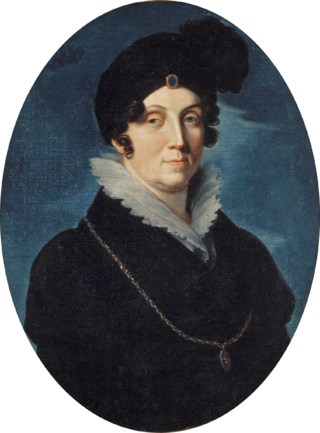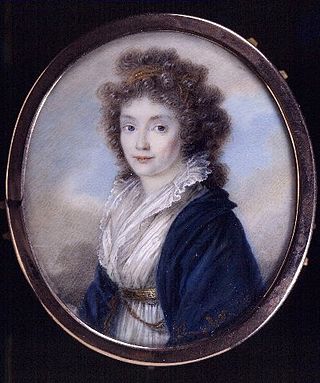Related Research Articles

Charles XIII, or Carl XIII, was King of Sweden from 1809 and King of Norway from 1814 to his death. He was the second son of King Adolf Frederick of Sweden and Louisa Ulrika of Prussia, sister of Frederick the Great.

Sophia Magdalena of Denmark was Queen of Sweden from 1771 to 1792 as the wife of King Gustav III.

Princess Sophia Albertina of Sweden was the last Princess-Abbess of Quedlinburg Abbey, and as such reigned as vassal monarch of the Holy Roman Empire.

Princess Amalie of Hesse-Darmstadt was a Hereditary Princess of Baden by marriage to Charles Louis, Hereditary Prince of Baden. She was the daughter of Ludwig IX, Landgrave of Hesse-Darmstadt and Henriette Karoline of Palatine-Zweibrücken.

Hedwig Elisabeth Charlotte of Holstein-Gottorp was the queen consort of Charles XIII of Sweden and II of Norway. She was also a famed diarist, memoirist and wit. She is known as Hedwig Elisabeth Charlotte, though her official name as queen was Charlotte (Charlotta).

Prince Frederick Adolf, Duke of Östergötland was a Swedish Prince, youngest son of King Adolf Frederick of Sweden and Louisa Ulrika of Prussia, a sister of Frederick the Great, King of Prussia. He was given the title Duke of Östergötland.

Fredrika Charlotte "Lolotte" Forssberg (1766–1840) was a Swedish noble and lady-in-waiting, later countess Stenbock. She was one of the most talked about people of her time as the possible child of King Adolf Frederick of Sweden. Princess Sophia Albertina of Sweden investigated her birth in the 1790s and tried to have her acknowledged as the daughter of her father. The truth is unconfirmed, though it is considered likely that she was the illegitimate daughter of the king.

Countess Christina Augusta Löwenhielm, was a Swedish noblewoman and courtier. She is known for her love affair with the later Charles XIII of Sweden. She is also famous in history as one of "the three graces" of the Gustavian age; three ladies-in-waiting immortalized in the poem Gracernas döpelse by Johan Henric Kellgren, and known profiles of the epoch.

Adolf Fredrik, Count Munck, was a Swedish and Finnish noble during the Gustavian era. His family name is sometimes inaccurately given as "Munck af Fulkila" because his father usurped this family's title in the Swedish Diet but, as a matter of fact, without genealogical justification.

Maria Charlotta Cedercreutz, married surname Wrangel (1736–1815), was a Swedish artist, lady-in-waiting and baroness. She was a member of the Royal Swedish Academy of Arts.

Hedvig "Hedda" Eleonora von Fersen was a Swedish noble and a lady in waiting to the Swedish queen, Sophia Magdalena of Denmark. She was the daughter of Axel von Fersen the Elder and Hedvig Catharina De la Gardie, and the sister of Count Axel von Fersen the Younger, Sophie Piper and Fabian von Fersen (1762–1818). In 1773, she married marshal Baron, later Count Thure Leonard von Klinkowström in his second marriage, and with him had four children, among them was the artist Hedvig Amalia Charlotta Klinckowström and Count Axel Leonhard von Klinckowström, member of the Royal Swedish Academy of War Sciences and la Société pour l'encouragement de l'industrie nationale.
Anna Sofia Ramström (1738–1786) was a kammarfru of the Queen of Sweden, Sophie Magdalena of Denmark. She was known for her involvement in the famous affair of the consummation of the marriage between the royal couple.

Princess Charlotte Amalie of Denmark and Norway was a Danish princess, daughter of King Frederick IV of Denmark and Louise of Mecklenburg-Güstrow.

Ulrika "Ulla" Eleonora von Höpken, later von Wright, née von Fersen, was a Swedish countess and courtier. She is also famous in history as one of "the three graces" of the Gustavian age; three ladies-in-waiting immortalized in the poem Gracernas döpelse by Johan Henric Kellgren. She was a leading socialite and trendsetter in contemporary Sweden, and one of the best known personalities of the Gustavian age.
Maria Aurora Uggla, married name Ehrengranat (1747–1826), was a Swedish lady in waiting and noble. She was the lady in waiting and confidant of the Swedish Queen, Sophia Magdalena of Denmark, and later the head of the court of Crown Prince Gustav Adolf.

Hedvig Ulrika De la Gardie, was a Swedish lady-in-waiting. She was married to Gustaf Mauritz Armfelt. She was the head governess of the Swedish royal children in 1799–1803.

Charlotta "Lotta" Fredrika Sparre, commonly named Lotta Sparre, was a Swedish noble and courtier.

Marie of Baden was Duchess of Brunswick-Wolfenbüttel and Brunswick-Oels. She was married to Frederick William, Duke of Brunswick-Wolfenbüttel.
Ulrica Eleonora Rålamb, née von Düben, was a politically active Swedish countess and socialite.
Hedvig Sofia von Rosen, née Stenbock was a Swedish countess and courtier. She was the överhovmästarinna of the future Gustav IV Adolf of Sweden in 1778–1781, and for his brother Prince Carl Gustav, Duke of Småland in 1782–1783.
References
- ↑ S:ta Eugenia katolska församlings latinska kyrkobok CI:1 (1784-1800), (bild 175 i SVAR
- Carl Carlson Bonde (1902). Hedvig Elisabeth Charlottas dagbok I (1775–1782). Stockholm: Norstedt & Söners förlag. Libris 8207712
- Cecilia af Klercker (1923). Hedvig Elisabeth Charlottas dagbok V 1795–1796. P.A. Norstedt & Söners förlag Stockholm. p. 47.
- Johan Christopher Barfod, Wilhelm Odelberg: Dagens märkvärdigheter, Volym 2. Natur & Kultur, 1967 sid 91-92